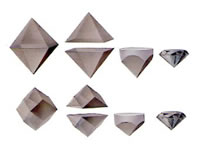 A newly mined rough diamond looks more like a piece of glass washed up on a beach than like the polished loose diamonds and diamond rings sold in jewelry stores. Bringing out their beauty requires the skill and art of a trained diamond cutter.
A newly mined rough diamond looks more like a piece of glass washed up on a beach than like the polished loose diamonds and diamond rings sold in jewelry stores. Bringing out their beauty requires the skill and art of a trained diamond cutter.
While incredibly precise, computerized machinery is now used in some parts of the cutting process for some diamonds, most of the work is still performed by hand using meticulous techniques passed down over the generations.
There are special techniques that are used to cut and shape a diamond before it gets to the jewelry store. Diamond cutting creates the facets that you see in the diagram above. Diamond cutters use these four basic techniques:
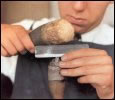 Cleaving – Not all diamond rough needs to be cleaved or sawed. Some diamond rough is well formed and can be considered ready to cut. If cleaving is necessary, a rough diamond is placed in quick-drying cement. A sharp groove is then carved into the diamond, using another diamond or a laser, along planes of weakness. Then, a steel blade is placed in the groove and a sharp blow to the blade splits the stone. It is then removed from the cement.
Cleaving – Not all diamond rough needs to be cleaved or sawed. Some diamond rough is well formed and can be considered ready to cut. If cleaving is necessary, a rough diamond is placed in quick-drying cement. A sharp groove is then carved into the diamond, using another diamond or a laser, along planes of weakness. Then, a steel blade is placed in the groove and a sharp blow to the blade splits the stone. It is then removed from the cement.
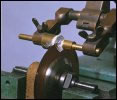 Sawing – Sometimes, diamonds have to be cut against a cleavage plane, which cannot be done with cleaving. Using a phosphor-bronze blade rotating at about 15,000 rpm, the saw slowly cuts through the diamond. Lasers are also being used to saw diamonds.
Sawing – Sometimes, diamonds have to be cut against a cleavage plane, which cannot be done with cleaving. Using a phosphor-bronze blade rotating at about 15,000 rpm, the saw slowly cuts through the diamond. Lasers are also being used to saw diamonds.
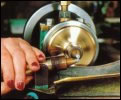 Bruting – The diamond is placed in a lathe, and another diamond in the lathe is rubbed against it to create the rough finish of the girdle, the outside rim of the diamond at the point of largest diameter. By grinding away the edges, bruting provides the outline shape (for example, heart, oval or round) for the diamond.
Bruting – The diamond is placed in a lathe, and another diamond in the lathe is rubbed against it to create the rough finish of the girdle, the outside rim of the diamond at the point of largest diameter. By grinding away the edges, bruting provides the outline shape (for example, heart, oval or round) for the diamond.
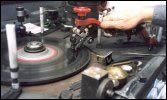 Polishing – Cross-working is the first step of the polishing process. The function of cross-workers is to lay the foundation of the diamond and to follow the instructions to obtain the optimum value for the finished product. The optimum value is a compromise between a bigger diamond, cutting away inclusions and the proportions of the finished stone.
Polishing – Cross-working is the first step of the polishing process. The function of cross-workers is to lay the foundation of the diamond and to follow the instructions to obtain the optimum value for the finished product. The optimum value is a compromise between a bigger diamond, cutting away inclusions and the proportions of the finished stone.
The work is done on a polishing disc driven by an electric motor. The disc is covered with diamond powder. The diamond to be polished is held in a clamp and the facets are polished one by one. Cross-workers polish 18 facets (table, culet, bezel and pavilion main facets) to very stringent measurements and angles onto the stone.
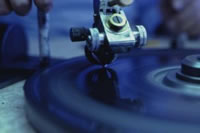 Brillianteering is the final step of the polishing process. The function of brillianteers is to polish 40 facets (star, upper girdle and lower girdle facets) onto the already polished facets done by the cross-workers, in order to create a round brilliant cut diamond with 58 facets that will unlock the full brilliance and fire of light being reflected by the polished diamond.
Brillianteering is the final step of the polishing process. The function of brillianteers is to polish 40 facets (star, upper girdle and lower girdle facets) onto the already polished facets done by the cross-workers, in order to create a round brilliant cut diamond with 58 facets that will unlock the full brilliance and fire of light being reflected by the polished diamond.
Once the fully faceted diamond has been inspected and approved, it is boiled in hydrochloric and sulfuric acids to remove dust and oil. The diamond is then considered a finished, polished gem. These loose diamonds are now ready to be distributed to wholesalers and manufacturers and ultimately to retailers for diamond engagement rings and diamonds rings for the diamond shopping consumer.

